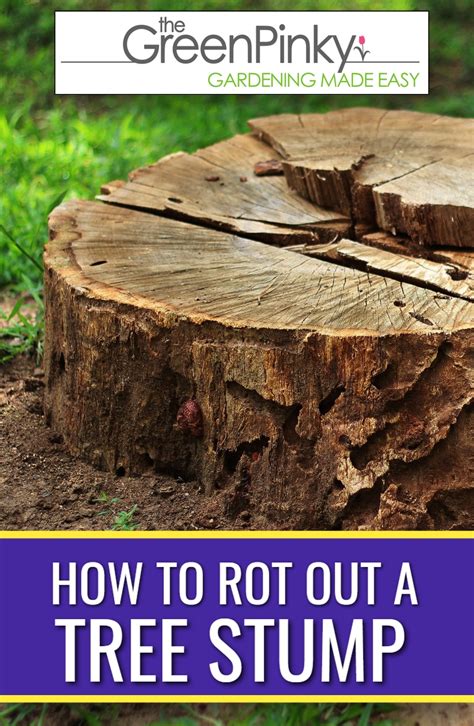How To Rot A Stump Fast
Ronan Farrow
Apr 02, 2025 · 3 min read

Table of Contents
How to Rot a Stump Fast: The Ultimate Guide to Stump Removal
Removing a tree stump can be a tedious task, but there are ways to accelerate the natural decomposition process. This guide will walk you through effective methods to rot a stump fast, saving you time and effort.
Understanding Stump Decomposition
Before diving into the methods, it's crucial to understand the process. Stumps decompose naturally through the action of fungi and bacteria. These microorganisms break down the cellulose and lignin in the wood, eventually turning it into nutrient-rich soil. However, this natural process can take years, even decades. Our goal is to significantly speed it up.
Factors Affecting Decomposition Speed
Several factors influence how quickly a stump rots:
- Wood type: Hardwoods like oak decompose slower than softwoods like pine.
- Stump size: Larger stumps naturally take longer to break down.
- Moisture levels: Consistent moisture is essential for microbial activity.
- Temperature: Warmer temperatures promote faster decomposition.
- Exposure to air: Sufficient oxygen is crucial for the fungi and bacteria to thrive.
Effective Methods to Rot a Stump Fast
Here are some proven methods to accelerate the decomposition process:
1. Drilling Holes and Adding Decay Accelerants
This is a highly effective method. By drilling numerous holes into the stump, you increase the surface area exposed to decay-promoting agents.
- Drilling: Use a drill bit of at least 1 inch diameter and drill holes about 12-18 inches deep, spaced approximately 6 inches apart across the stump's surface.
- Accelerants: There are various commercial stump rot accelerators available. These often contain nitrogen-based fertilizers, which help stimulate the growth of decay-causing microorganisms. Alternatively, you can use naturally occurring materials such as urea fertilizer, or potassium nitrate.
2. Covering with Nitrogen-Rich Materials
Covering the stump with materials rich in nitrogen can further boost decomposition.
- Materials: Excellent options include compost, manure, or grass clippings. These materials provide a source of nitrogen, which helps feed the microbes responsible for decomposition.
- Application: Create a thick layer (at least 6 inches) around and over the stump, ensuring good contact with the wood.
3. Maintaining Moisture Levels
Moisture is critical for microbial activity. If the stump is in a dry area, you'll need to ensure consistent moisture.
- Watering: Regular watering is essential. Keep the area around and on top of the stump consistently moist, but not waterlogged.
4. Using Stump Grinding (For Complete Removal)
While not strictly "rotting," stump grinding is a quick and effective method for complete stump removal. A stump grinder efficiently chips the stump into small pieces, making it easier to dispose of or work into the soil. Consider this option if you need the area cleared quickly.
Choosing the Right Method
The best method depends on your individual circumstances. For a small stump and a bit of patience, the combination of drilling, adding an accelerant, and maintaining moisture is often sufficient. For larger stumps or when you need faster results, consider combining methods or using a stump grinder.
Accelerating Nature's Process
Remember, while these methods significantly accelerate the decomposition process, it still takes time. Be patient, and you will eventually have the stump rotted away, leaving behind nutrient-rich soil for your garden. Consistent application and monitoring are key to success.
Featured Posts
Also read the following articles
| Article Title | Date |
|---|---|
| How To Put Out Corn For Deer | Apr 02, 2025 |
| How To Tighten Oil Drain Plug Without Torque Wrench | Apr 02, 2025 |
| How To Test Rear Window Defogger | Apr 02, 2025 |
| How To Sbr A Rifle Lower | Apr 02, 2025 |
| How To Restain A Swing Set | Apr 02, 2025 |
Latest Posts
-
How Big Of A Travel Trailer Can I Tow
Apr 03, 2025
-
How Big Of A Pool Pillow Do I Need
Apr 03, 2025
-
How Big Of A Patio Umbrella Do I Need
Apr 03, 2025
-
How Big Of A Camper Can An F150 Pull
Apr 03, 2025
-
How Big Of A Boat Can I Drive
Apr 03, 2025
Thank you for visiting our website which covers about How To Rot A Stump Fast . We hope the information provided has been useful to you. Feel free to contact us if you have any questions or need further assistance. See you next time and don't miss to bookmark.
